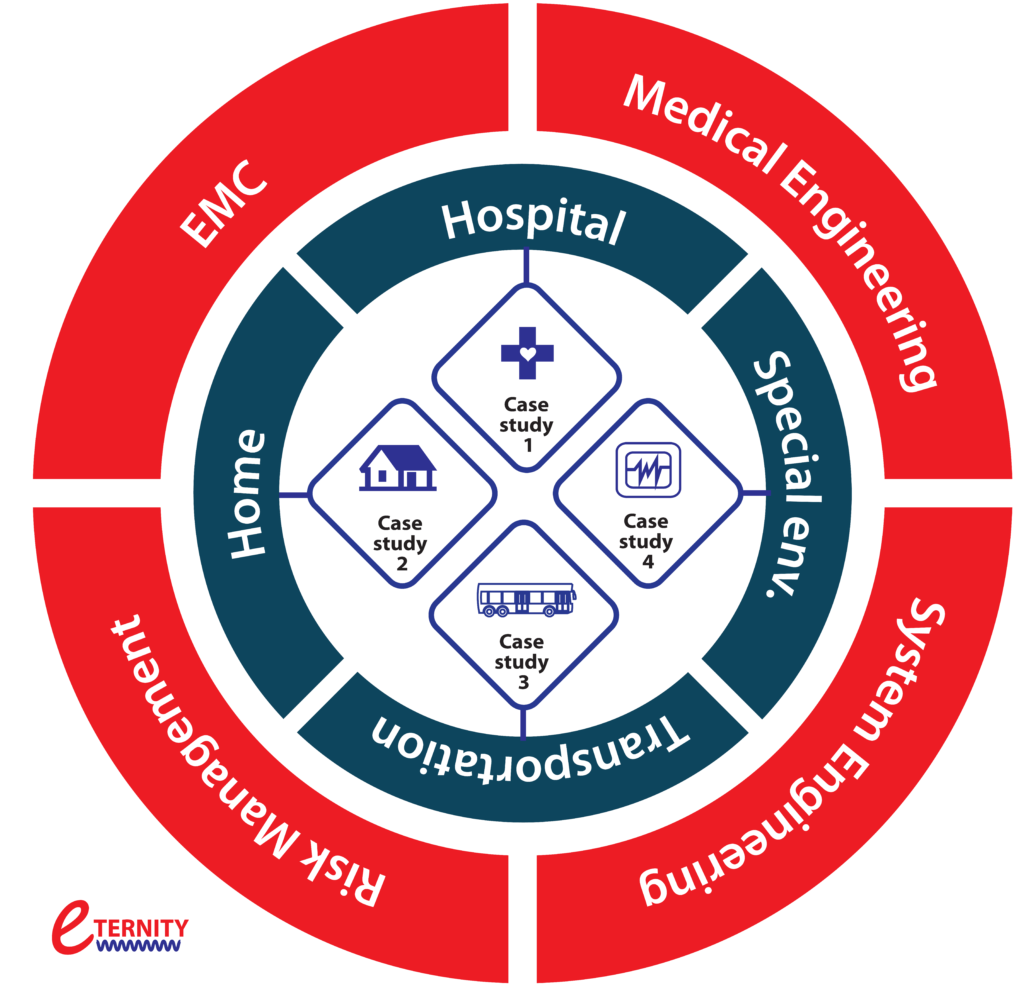ETERNITY will create a long-lasting multidisciplinary, academic-industrial network for doctoral training, with leading European industries and academia, to achieve a breakthrough in the design of innovative medical equipment where the risk of EMI has been managed at its core: with wearables, with on-board platforms and with collaborative care systems for hospitals.
ETERNITY is about including the risk management of EMI in the design of innovative, electronic medical equipment. This shift is both urgently needed and mandatory.
The key targets of ETERNITY are:
- Scientific: to propose and master solutions to the scientific challenges of the inclusion of EMI risks into the electronic design of medical equipment (ranging from wearables with biosensors to complex systems of systems).
- Training: to steer a dedicated group of young European pioneers towards leading positions in the highly innovative field of electronic designs for medical technology.
- Industry-academia network: to build a direct international transfer path, involving people and technology, between leading European universities and industries across all sectors of the medical technology market.
- Society: to enable safe and reliable medical equipment and innovation, in our modern environments: in medical institutions, at home and while being on the move.
ETERNITY will focus on Social Challenges (SCs) and Technology Challenges (TCs) as shown in Fig 3. The SCs and TCs result in 4 S/T Work Packages (WPS) that will be addressed within the context of the ETERITY research and training program. A more detailed description of the SCs and TCs is provided below.

SC1: To improve the quality of care with collaborative systems.
The trend of co-locating high-tech medical equipment in EMI-heavy hospital environments is raising some very serious concerns. Hybrid operating rooms are becoming common for minimally invasive surgery. This surgical theatre is equipped with advanced medical imaging devices such as fixed C-Arms, X-Ray, CT or MRI scanners. To improve the quality of care, improved MRI systems with guided robotic intervention or combined hyperthermia treatment are being developed. These expanding departments with advanced systems of systems are known to be very sensitive to electromagnetic disturbances.
SC2: To enable a shift from care to prevention with wearables.
EMI incidents related to wearables have shown a sharp increase in the past 4 years, while at the same time a gradual shift has taken place, with prevention and care taking place away from the hospital environment. This means that medical devices have to become more resilient to everyday electronics at home, in the workplace and when on the move. Wearables, the Internet of Things (IoT) and 5G technologies are playing an increasing role. They are for instance used to detect the onset of, to diagnose, and to delay the progression of disease detection for cardiac arrhythmia or motor fluctuations in Parkinson’s patients, help in retaining the memories in patients with Alzheimer’s and the diagnosis of diseases such as diabetes and cystic fibrosis. New, high-tech, electronic medical devices need to be able to operate safely when surrounded by everyday electronic equipment that produces a lot of EMI.
SC3: To ensure safe travels with biosensing on board platforms.
Although vehicles are not readily seen as a medical environment, biometric sensors or biosensors are poised for use in vehicles to monitor drivers’ vital signs, stress and emotional state. Such sensors can be placed in seats, seatbelts or on the steering wheel. Driver-monitoring systems will become ubiquitous in the highly automated vehicles of the near future to assess the driver’s physical state and awareness (responsible for over 90% of accidents), and might need to take over in the case of an emergency. There is a growing need to curb road fatalities arising from drunken driving and to assist elderly drivers who have slower responses.

TC1: To develop a methodology for the three steps of the risk management of electronic medical system
The goal is to ensure equipment will maintain electromagnetic compatibility (EMC) across a multitude of environments and scenarios of use, despite these systems being subjected to complex EMI threats. The risk-based approach (which will eventually replace the outdated, rule-based approach in medical technology) involves 3 steps: hazard-and-risk analysis, risk reduction, verification & validation. These three steps are the backbones of the ETERNITY programme.
TC2: To develop necessary tools addressing specifically the complexity, reconfigurability and versatility of medical scenarios
EMI risks for new medical equipment and systems need to be addressed throughout the whole design process, i.e., from the earliest concept to deployment in all the intended environments, particularly EMI-harsh ones. Eternity includes applications such as a collaborative integrated medical system (with MRI and X-ray), plasma-based healing instruments, implantable and wearable sensing devices, and on-board sensing platforms. They all come together with their wireless communication systems. More conventional, but rapidly evolving, medical facilities in hospitals are also represented.
TC3: To address the challenge of EMI in time domain in medical scenarios
More wireless digital communication systems (DCSs) are used in all environments and are becoming the primary link between patients and medical professionals. These DCSs, using signals in the time domain, have to be designed to work harmoniously in the context of various types of EMI signals and transients. Perhaps the greatest worry is that immunity testing in electromagnetic compatibility (EMC) standards only covers one EMI disturbance at a time, meaning that simultaneous EMI effects are not addressed. This point is especially relevant as medical equipment is increasingly interacting with everyday electronic equipment (5G technologies and IoT). These DCSs have to be designed to work harmoniously in the context of various types of EMI signals and transients.
